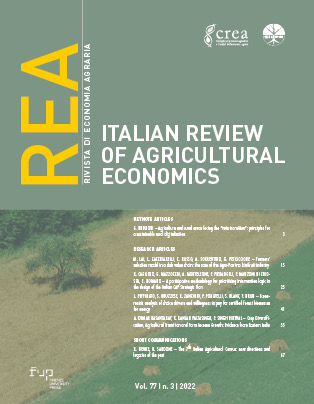A participative methodology for prioritising intervention logic in the design of the Italian CAP Strategic Plan
Published 2022-11-25
Keywords
- CAP,
- CSP,
- needs,
- prioritisation,
- governance arrangements
How to Cite
Abstract
The new CAP implementation model requires each Member State to design a CAP Strategic Plan (CSP) to deliver operational actions under the two CAP pillars. Each CSP must be built from an evidence-based needs assessment that undergoes rigorous prioritisation to plan comprehensive and achievable interventions. In Italy, the institutional context requires all the Regions and Autonomous Provinces to express their preferences and to discuss the CSP collectively, both as regards identifying territorial needs and their prioritisation. In this framework, it became pertinent to introduce a specific instrument to facilitate participation in this process. The Italian Ministry, in collaboration with the National Rural Network, developed a participatory route to assess the prioritisation of the identified needs, to support the decision-making process in CSP drafting process. The process is primarily based on a voting aggregation technique called the Constrained Cumulative Voting method. The process identified makes it possible, on the one hand, to formulate a shared consensus on the level of importance of each need; on the other one, via the definition of natural breaks, to determine homogeneous groups of needs by importance of intervention. This process is in line with the European Commission’s legislative proposals requiring a sound and well-founded logic of intervention.
Downloads
References
- Achimugu P., Selamat A., Ibrahim R., Mahrin M.N. (2014). A systematic literature review of software requirements prioritization research. Information and Software Technology, 56: 568-585. DOI: https://doi.org/10.1016/j.infsof.2014.02.001
- Amrhein J. (2019). Dot Voting Tips. Michigan State University Extension.
- Angeli S., Cagliero R., De Franco R., Mazzocchi G., Monteleone A., Tarangioli S. (2020). La definizione delle esigenze nel Piano Strategico della Pac 2023-2027. Working Document, Rete Rurale Nazionale 2014-2020, Mipaaf, Roma, Italy
- Asch S.E. (1951). Effects of group pressure upon the modification and distortion of judgments. In: Guetzkow H. (eds) Leadership and Men (pp. 177-190). Carnegie Press: Pittsburgh, PA, USA
- Cagliero R., Bellini F., Marcatto F., Novelli S., Monteleone A., Mazzocchi G. (2021). Prioritising CAP Intervention Needs: An Improved Cumulative Voting Approach. Sustainability, 13(7), 3997. DOI: https://doi.org/10.3390/su13073997
- Carey M. (2019). The Common Agricultural Policy’s New Delivery Model Post-2020: National Administration Perspective. EuroChoices, 18: 11-17. DOI: https://onlinelibrary.wiley.com/doi/10.1111/1746-692X.12218
- COMMISSION DELEGATED REGULATION (EU) 240/2014 of 7 January 2014 on the European code of conduct on partnership in the framework of the European Structural and Investment Funds
- Dennison M. (2000). Voting with Dots. Thread from a Discussion on the Electronic Discussion on Group Facilitation
- Erjavec E. (2020). Reflections of CAP strategic planning in times of corona, CAP Reform
- Erjavec E., Lovec M., Juvančič L., Šumrada T., Rac I. (2018). The CAP Strategic Plans beyond 2020. In: Assessing the Architecture and Governance Issues in Order to Achieve the EU-Wide Objectives (p. 52.). Study Requested by the AGRI Committee, European Parliament, Policy Department for Structural and Cohesion Policies. Brussels, Belgium
- Erjavec E., Lovec M., Šumrada T. (2020). New CAP Delivery Model, Old Issues. Intereconomics, 55(2): 112-119. DOI: 10.1007/s10272-020-0880-6
- Khan F. (2012). An initial seed selection algorithm for k-means clustering of georeferenced data to improve replicability of cluster assignments for mapping application. Applied Soft Computing, 12(11). DOI: https://doi.org/10.1016/j.asoc.2012.07.021
- Gibbons S. (2019). Dot Voting: A Simple Decision-Making and Prioritizing Technique.
- Gu Y., Hao T., Cheng D., Wang J., Cheng F. (2020). Consensus Model with Double Feedback Mechanism Based on Dynamic Trust Relationship in Social Network Group Decision-Making. International Journal of Computational Intelligence Systems. DOI: https://doi.org/10.2991/ijcis.d.201228.001
- Kohavi R., Henne R.M., Sommerfield D. (2007). Practical Guide to Controlled Experiments on the Web: Listen to Your Customers not to the Hippo. In Proceedings of the 13th ACM SIGKDD International conference on Knowledge Discovery and Data Mining, San Jose, CA, USA, 12-15 August 2007, Association for Computing Machinery (pp. 959-967), New York, NY, USA
- Mac Carron P., Kaski K., Dunbar R. (2016). Calling Dunbar’s numbers. Social Networks, 47. DOI: https://doi.org/10.1016/j.socnet.2016.06.003
- Marcatto F. (2021). Dot Voting: Because One Vote Is Not Enough
- Matthews A. (2021). Evaluating the Legislative Basis for the New CAP Strategic Plans
- Mazzocchi G., Cagliero R., Angeli S., Monteleone A., Tarangioli S. (2020). Verso una prioritizzazione delle esigenze nel Piano Strategico Nazionale PAC 2023-2027. Rete Rurale Nazionale 2014-2020, Mipaaf, Roma
- Mazzocchi G., Cagliero R., Monteleone A., Angeli S., Monteleone A., Tarangioli S. (2021). La prioritizzazione delle esigenze nel Piano Strategico Nazionale PAC 2023-2027. Rete Rurale Nazionale 2014-2020, Mipaaf, Roma
- Nadeau R., Cloutier E., Guay J.-H. (1993). New Evidence about the Existence of a Bandwagon Effect in the Opinion Formation Process. International Political Science Review, 14(2): 203-213. DOI: https://doi.org/10.1177/019251219301400204
- Pierangeli F. (2020). La riforma della PAC 2021-2027: il percorso di programmazione strategica in Italia. PianetaPSR, 88
- Skowron P., Slinko A., Szufa S., Talmon N. (2020). Participatory Budgeting with Cumulative Votes. arXiv 2020, arXiv:2009.02690v1
- Tang H., Wan S., Li C., Liang H., Dong Y. (2021). Consensus Reaching Process in the Two-Rank Group Decision-Making with Heterogeneous Preference Information. International Journal of Computational Intelligence Systems, 14(1): 758-768. DOI: https://doi.org/10.2991/ijcis.d.210201.001
- Tufail H., Qasim I., Faisal Masood M., Tanvir S., Haider Butt W. (2019). Towards the selection of Optimum Requirements Prioritization Technique: A Comparative Analysis. In Proceedings of the 5th International Conference on Information Management (ICIM 2019), Cambridge, UK, 24-27 March 2019, IEEE Digital Library. pp. 227-231. DOI: 10.1109/INFOMAN.2019.8714709
- Vestola M. (2010). A Comparison of Nine Basic Techniques for Requirements Prioritization. (pp. 1-8). Helsinki University of Technology: Helsinki, Finland
- Wu J., Dai L., Chiclana F., Fujita H., Herrera-Viedma E. (2018). A minimum adjustment cost feedback mechanism based consensus model for group decision making under social network with distributed linguistic trust. Information Fusion, 41: 232-242. DOI: 10.1016/j.inffus.2017.09.012


